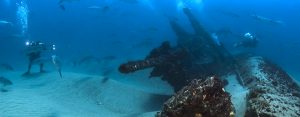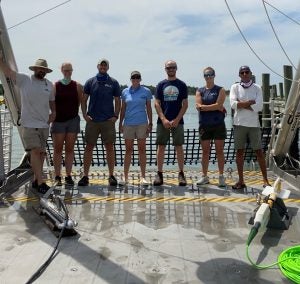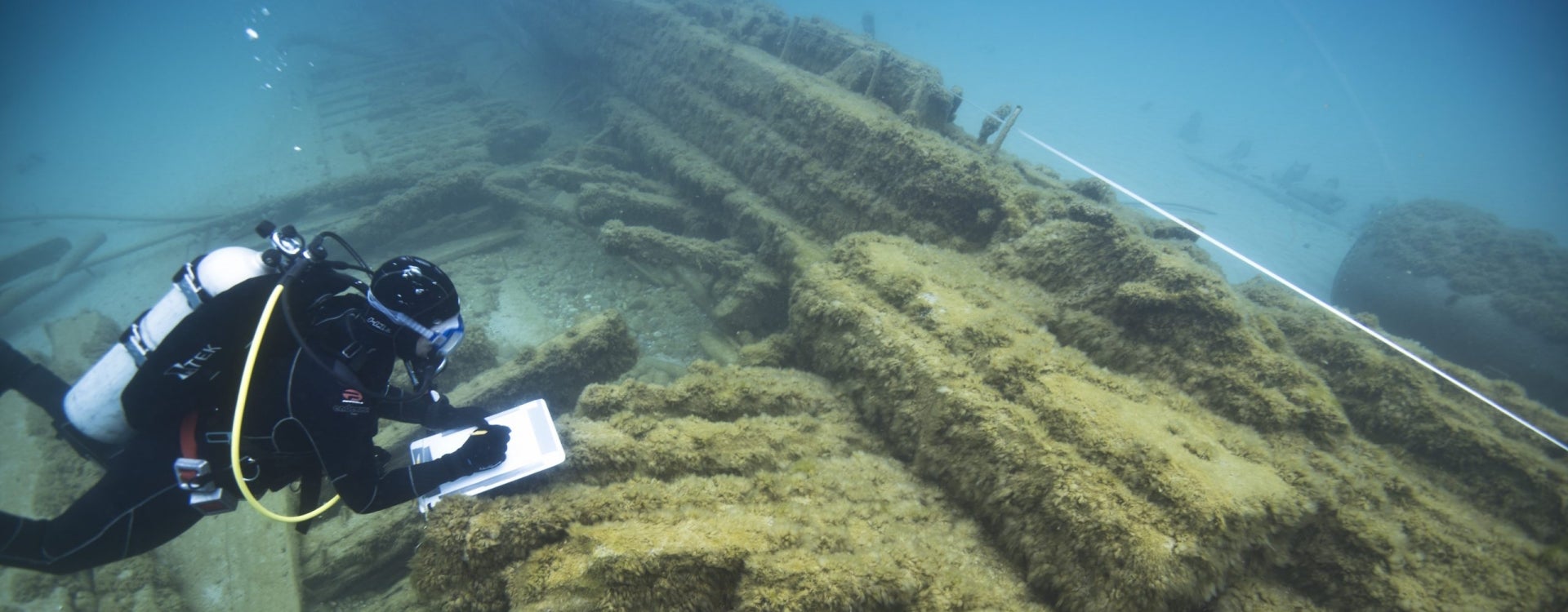NOAA
ECU/NOAA Partnership
The mission of the National Oceanic and Atmospheric Administration (NOAA) is, “To understand and predict changes in climate, weather, ocean, and coasts, to share that knowledge and information with others, and to conserve and manage coastal and marine ecosystems and resources.” It accomplishes this in part through the continued establishment and maintenance of National Marine Sanctuaries in which it conserves and manages special ocean areas deemed to be of irreplaceable national significance. In 2019 the Program in Maritime Studies and NOAA’s Maritime Heritage Program entered into a Memorandum of Agreement (MOA) for the purpose of collaborative research, education, and outreach. This MOA came about after over two decades of cooperation. Indeed, since 1997, East Carolina University’s Program in Maritime Studies has been partnering with NOAA to support research within the National Marine Sanctuary system and study the nation’s underwater cultural heritage.
Project Synopses
As a part of this larger partnership, students and faculty of the Program in Maritime Studies have contributed toward the protection and study of underwater cultural heritage in NOAA’s care through class projects, internships, theses, and dissertations. These have been the result and instigation of numerous collaborative projects with new initiatives being developed and executed each year. Please note that the synopses below have been pieced together from the programs publication Stem to Stern and augmented with other documents. Errors can be corrected, and content added by contacting the program.
1997: Dr. Gordon Watts conducts a survey of four sites under consideration for inclusion in a shipwreck trail in NOAA’s Florida Keys National Marine Sanctuary (the Delta Shoals Shipwreck Sites B and D, the Rock Key Tile Wreck, and the Alexander shipwreck site).
2001: Frank Cantelas assists with the pre-disturbance survey and completes other dives in preparation for the recovery of the USS Monitor engine by the US Navy, NOAA, and the National Undersea Research Center at the University of North Carolina.
2002: Staff archaeologist Frank Cantelas assists with the excavation of USS Monitor for a second consecutive year.
The ECU Program in Maritime Studies Diving and Water Safety Office participate in the NOAA investigation of a mystery wreck near Islamorada, Florida Keys.
2003: Dr. Timothy Runyan and Frank Cantelas are awarded a NOAA Ocean Exploration grant to conduct the Outer Banks Shipwreck Survey near Ocracoke, NC.
2004: Dr. Bradley Rodgers participates in Dr. Hans Van Tilburg’s research expedition to the remote Kure and Midway atolls in NOAA’s Northwestern Hawaiian Islands Coral Reef Ecosystem Reserve to conduct a remote sensing survey and map shipwrecks. The project leads to the discovery of the remains of USS Saginaw in addition to possible remains of American whaler Parker. The remains of USS Macaw and Carrollton were also surveyed and mapped.
Under the direction of Dr. Bradley Rodgers and Dr. Nathan Richards in Maritime Studies document the shipwreck Monohansett and the Great Lakes fishing tug Katherine V for the Thunder Bay National Marine Sanctuary and Underwater Preserve in Alpena, Michigan as a part of its summer field school.
Dr. Timothy Runyan and Frank Cantelas, along with MA students (Chris McCabe, Franklin Price, and Sam Blake) collaborate on the NOAA-led mission to search for the USS Alligator off the coast of North Carolina.
2005: Dr. Lawrence Babits and Dr. Nathan Richards are awarded a NOAA Ocean Exploration grant to explore North Carolina’s Roanoke and Perquimans Rivers.
Under the direction of Dr. Bradley Rodgers and Dr. Nathan Richards, a field school was held including vessel remnants off North Point, Thunder Bay in the Thunder Bay National Marine Sanctuary.
Frank Cantelas assists a NOAA-led project to document two schooners, E.B. Allen and an unidentified vessel named Target 7 (via scuba and ROV) and helps conducts an initial exploration of other sites such as Montana and Grecian in Thunder Bay National Marine Sanctuary and Underwater Preserve. These projects also represent a collaboration with the NOAA Maritime Archaeology Center and Office of Ocean Exploration.
Dr. Timothy Runyan and Frank Cantelas the ECU Program in Maritime Studies participates in the remote sensing search for USS Alligator with Office of Naval Research and NOAA near Cape Hatteras (the project is featured on the Discovery Channel).
2006: The ECU Program in Maritime Studies assisted with an archaeological, oceanographic, and ecological survey and datum-baseline establishment in the Northwestern Hawaiian Islands and Pearl and Hermes Atoll in cooperation with NOAA.
Graduate student Calvin Mires interns at the NOAA Thunder Bay National Marine Sanctuary and Underwater Preserve.
2007: With the assistance of NOAA’s Hawaiian Islands Humpback Whale National Marine Sanctuary (Dr. Hans Van Tilburg and Dr. Kelly Gleason), Dr. Richards, Dr. Rodgers, and Calvin Mires lead students to Oahu and Kauai to examine the floating museum ship Falls of Clyde (Oahu) and record the wreck of Ivanhoe (Kauai).

2008: Dr. Nathan Richards participates in the survey of three German U-boats lost off the coast of North Carolina (U-352, U-85, and U-701), as a part of the first year of the NOAA Battle of the Atlantic Expedition, a joint project between NOAA (Monitor National Marine Sanctuary), ECU, NPS, the North Carolina Department of Cultural Resources, and the University of North Carolina Coastal Studies Institute.
2009: The ECU Program in Maritime Studies participated in the second year of the NOAA Battle of the Atlantic Expedition to survey and document conditions of known vessels, document marine life on vessels, search for undiscovered Allied war casualties, in particular HMT Bedfordshire, and conduct tests and take measurements on U-352 and U-85, near Beaufort, NC. A separate mission in 2009 sees a NOAA-led team of archaeologists (including alumni Joe Hoyt and Tane Casserley) and including ECU personnel (Dr. Nathan Richards) on board the NOAA vessel Nancy Foster. The expedition concludes with the discovery of the WW2-loss YP-389.
2010: The ECU Program in Maritime Studies participated in the third year of fieldwork for NOAA’s Battle of the Atlantic Expedition documenting Allied casualties such as merchant vessels E.M. Clark, Manuela, Empire Gem, Dixie Arrow, and U.S. Navy Tug Keshena. ECU participated in the mapping of Dixie Arrow and Keshena.
Graduate student Stephanie Gandulla was the Cooperative Institute for Limnology and Ecosystems Research Fellow for three summer months at NOAA Thunder Bay National Marine Sanctuary, conducting reconnaissance, outreach, and exhibit design projects.
2011: For a fourth year, ECU (Dr. Nathan Richards, ECU MA student John Bright) participate in the NOAA-led Battle of the Atlantic Expedition, this time focusing on searching for potential remains of the KS-520 convoy battle (off Hatteras, NC).
2012: John Bright, Nathan Richards, Joseph Hoyt, John Wagner, and Tom Allen complete “The Battle of the Atlantic Expedition 2011: The Battle of Convoy KS-520 North Carolina, 15 July 1942.” The report completes an American Battlefield Protection Program award granted to Richards and Allen for a portion of the NOAA-led expedition of the previous year.
2013: Under the direction of Dr. Bradley Rodgers and Dr. Lynn Harris, the ECU Program in Maritime Studies record W.P. Rend and Ogarita in addition to conducting survey and recording activities at numerous small sites in Thunder Bay National Marine Sanctuary with NOAA as part of its summer field school.
Graduate students Zack Mason and Tom Horn intern at the NOAA Aquarius Reef Base.
Graduate student Phil Hartmeyer interns with the NOAA Maritime Heritage Program in Thunder Bay National Marine Sanctuary participating in education, outreach, and research initiatives including diving Pewabic.
2015: Graduate student Will Sassorossi interns at the NOAA Office of National Marine Sanctuaries, Silver Springs, Maryland, studying the economic value of cultural landscapes in National Marine Sanctuaries.
Graduate students Greg Stratton, Tom Horn, Jeremy Borrelli, Ryan Bradley, Jim Pruitt, Ivor Mollema, and Nicholas DeLong intern at the NOAA Aquarius Reef Base, Florida Keys National Marine Sanctuary.
Graduate student Kara Fox collaborates with Monitor National Marine Sanctuary and the Battle of the Atlantic Research and Expeditions Group (BAREG) to document the shipwreck Caribsea (lost off the coast of North Carolina).
2016: Graduate students Jeremy Borrelli, Ryan Bradley, and Nicholas DeLong participated in the NOAA recording of deep wrecks in Thunder Bay National Marine Sanctuary as safety-support divers after its boundaries were expanded. This included the documentation of the wreck of Northwestern.
Graduate student Melissa Price interns at NOAA monitoring known shipwreck sites, searching for new sites, and conducting terrestrial survey on select islands in Papahānaumokuākea Marine National Monument, Northwestern Hawaiian Islands as a part of the Reef Assessment and Monitoring Program.
2017: Graduate student Madeline Roth conducts a project with NOAA and the National Park Service to create digital outreach materials, including a story map to commemorate the Battle of Midway.
Graduate students Katherine Clevenger and Anne Wright along with Dive Safety Officer Jason Nunn continued a series of technical dives begun the previous year to survey shipwrecks in the newly expanded boundaries of the NOAA Thunder Bay National Marine Sanctuary.
2018: Graduate student Ryan Marr interns as a NOAA Explorer-In-Training on Okeanos Explorer, assisting with hydrographic mapping and survey of an unexplored area southeast of Bermuda as part of the international “Galway” research directive.
2019: Graduate student Tyler McLellan participates in a survey for the wreck of Revenue Cutter Bear with the NOAA Maritime Heritage Program.

ECU, NOAA, and Duke University personnel on 2020 Wimble Shoals Survey vessel R/V Shearwater.
2020: Program personnel Dr. Nathan Richards, Jeremy Borrelli, and Allyson Ropp along with NOAA employee Maddie Roth complete a sonar and magnetometer survey off Wimble Shoals, NC as a part of a NOAA Ocean Exploration Program grant held by NOAA Maritime Heritage Program director Joe Hoyt.
2021: Graduate students Matthew Lowe and Andrea Yoxsimer participated in a NOAA research cruise off the Outer Banks to survey and gather data on shipwrecks within the proposed expansion area of the Monitor National Marine Sanctuary.
Working under permit from the Maryland Historical Trust, graduate student Taylor Picard and Dr. Nathan Richards survey the unidentified “Sea Scout Wreck” in the Mallows Bay-Potomac River National Marine Sanctuary as a part of Taylor’s MA thesis research.
Release of “Battle of the Atlantic: A Catalog of Shipwrecks off North Carolina’s Coast from the Second World War” (OCS Study BOEM 2021-076/NOAA Maritime Heritage Report Series Number 6), representing the combined results of the NOAA led Battle of the Atlantic expedition work 2008-2018. The authorship team is made up of many ECU alumni and personnel including Joseph C. Hoyt (‘08), John C. Bright (‘12), Deborah Marx (‘02), Nathan Richards (faculty), William Sassorossi (‘15), Kara Davis (‘15), John Wagner (‘10), John McCord (faculty) The report comes out of a multi-agency partnership spanning a decade of collaborative work on North Carolina’s underwater cultural resources.
2023: Under the direction of Dr. Jennifer McKinnon and Dr. Nathan Richards, the ECU Program in Maritime Studies record HMS Loo, in addition to conducting survey and recording activities at numerous other sites near American Shoals and Looe Reef in the Florida Keys National Marine Sanctuary with NOAA as part of its fall field school.
List of Graduate Theses Created through ECU-NOAA collaboration
| Author | Year | Title | NOAA Program |
|---|---|---|---|
| Bright, John | 2012 | The Last Ambush: An Adapted Battlefield Analysis of the U-576 Attack Upon Allied Convoy KS-520 Off Cape Hatteras During the Second World War | Monitor NMS |
| Carroll, Elise Butchart | 2018 | Assessing the Management Practices of Historic Wreck Sites Containing Human Remains: USS Monitor , H. L. Hunley , USS Arizona , SS Caribsea and HMT Bedfordshire | Monitor NMS |
| Casserley, Tane | 2005 | CGS Canada: A Canadian Warship in the Florida Keys | Florida Keys NMS |
| Dappert, Claire P. | 2005 | Oaken Whale With A Cast Iron Tail: The Single-Decked Wooden Bulk Carrier Monahansett | Thunder Bay NMS |
| Fox, Kara Davis | 2015 | Matters of Steel: Illustrating and Assessing the Deterioration of the World War II Merchant Freight Caribsea | Monitor NMS |
| Freitas, Mitchell | 2016 | Reassessing the Cape Hatteras Minefield: An Examination of North Carolina Coastal Defenses during the Second World War | Monitor NMS |
| Friedman, Adam | 2008 | The Legal Choice in a Cultural Landscape: An Explanatory Model Created from the Maritime and Terrestrial Archaeological Record of the Roanoke River, North Carolina | NOAA Ocean Exploration Program |
| Leuchtmann, Amy | 2011 | The Central Places of Albemarle Sound: Examining Transitional Maritime Economies through Archaeological Site Distribution | NOAA Ocean Exploration Program |
| Pecoraro, Tiffany | 2007 | Great Lakes Ship Traps and Salvage: A Regional Analysis of An Archaeological Phenomenon | Thunder Bay NMS |
| Price, Franklin | 2006 | Conflict and Commerce: Maritime Archaeological Site Distribution as Cultural Change on the Roanoke River, North Carolina | NOAA Ocean Exploration Program |
| Sanchagrin, Stephen Paul | 2013 | A View Through the Periscope: Advanced and Geospatial Visualization of Naval Battlefields | Monitor NMS |
| Sassorossi, William S. | 2015 | Defending the East Coast: Adapting and Converting Commercial Ships for Military Operations | Monitor NMS |
| Wagner, John | 2010 | Waves of Carnage: A Historical, Archaeological and Geographical Study of the World War II Battle of the Atlantic in North Carolina Waters | Monitor NMS |
| Weir, Andrew | 2007 | A Historical and Archaeological Analysis of the Middle Island Life-Saving Station:Â Applying Site Formation Theory to Coastal Maritime Infrastructure Sites | Thunder Bay NMS |
| Whitesides, Scott | 2003 | Spatial Patterning Aboard the Millecoquins Wreck:Â Interpreting Ship Board Life and Functional Use of an Early 19th Century Great Lakes Sailing Vessel | Thunder Bay NMS |
List of ECU graduates who have worked for NOAA (work in progress)
